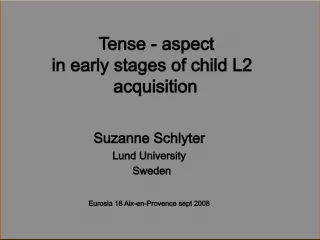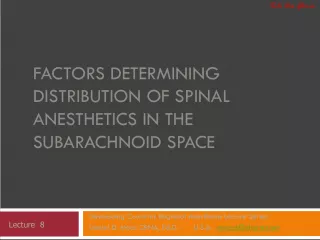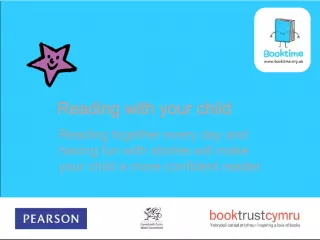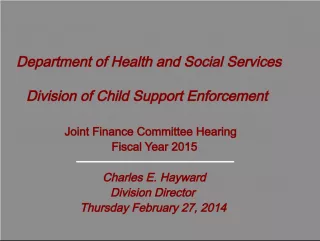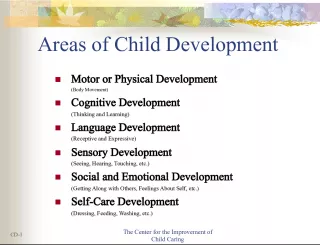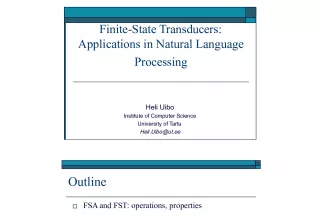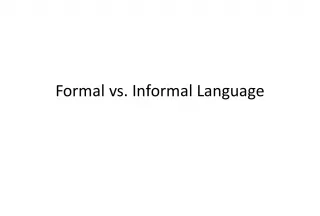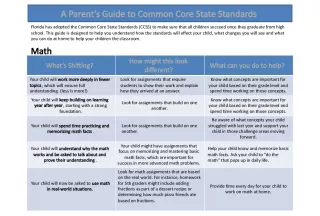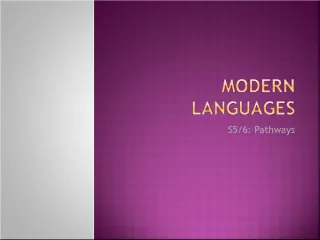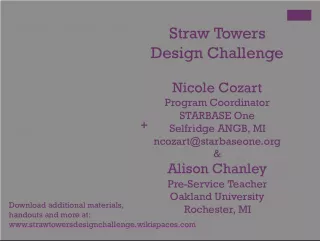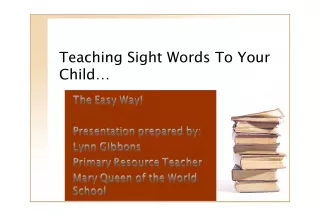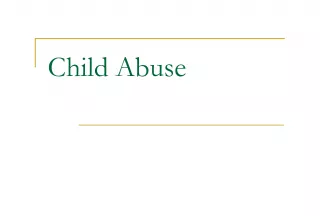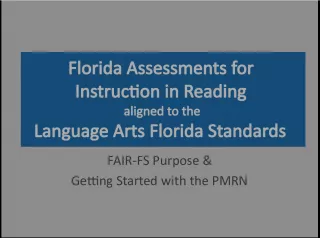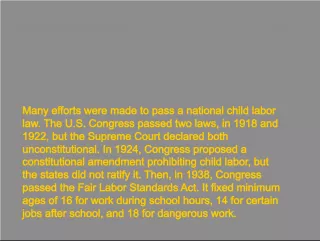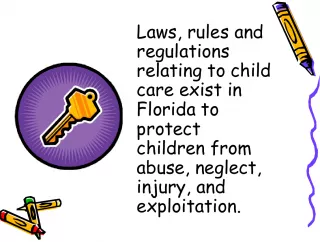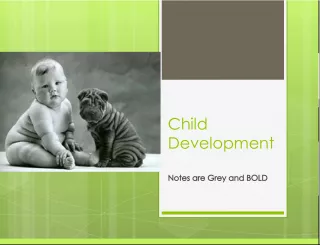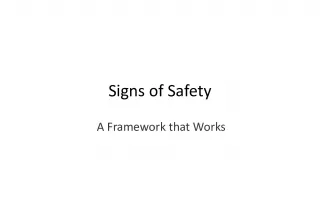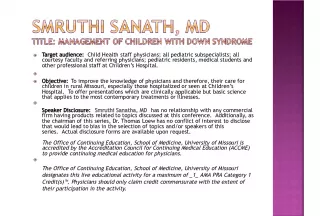Child Language and EBP: A Challenge, a Stimulus, and the Potential for Changed Roles between Researchers and Clinicians
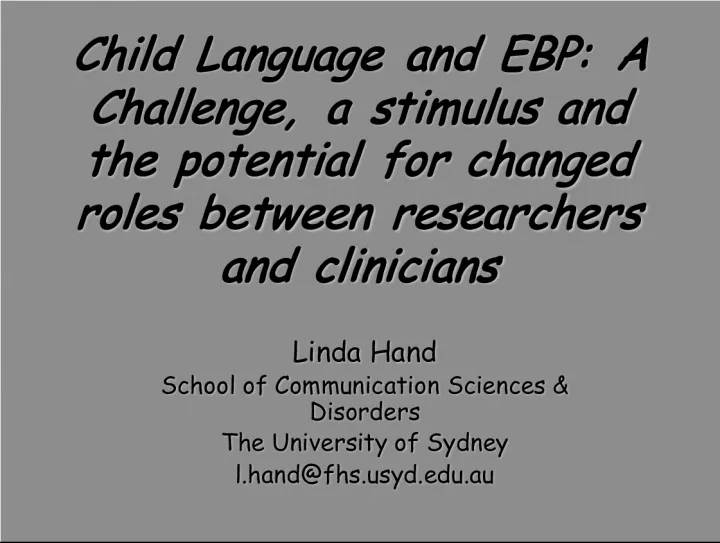

This article by Linda Hand, from the School of Communication Sciences and Disorders at the University of Sydney, explores
- Uploaded on | 2 Views
-
 emilyfoster
emilyfoster
About Child Language and EBP: A Challenge, a Stimulus, and the Potential for Changed Roles between Researchers and Clinicians
PowerPoint presentation about 'Child Language and EBP: A Challenge, a Stimulus, and the Potential for Changed Roles between Researchers and Clinicians'. This presentation describes the topic on This article by Linda Hand, from the School of Communication Sciences and Disorders at the University of Sydney, explores. The key topics included in this slideshow are . Download this presentation absolutely free.
Presentation Transcript
Slide1Child Language and EBP: A Challenge, a stimulus and the potential for changed roles between researchers and clinicians Child Language and EBP: A Challenge, a stimulus and the potential for changed roles between researchers and clinicians Linda Hand Linda Hand School of Communication Sciences & Disorders School of Communication Sciences & Disorders The University of Sydney The University of Sydney l.hand@fhs.usyd.edu.au l.hand@fhs.usyd.edu.au
Slide2The Challenge; to clinicians The Challenge; to clinicians The need to understand research better than we do The need to understand research better than we do to fairly critique it to fairly critique it eg. “small sample size” – the easy target that often misses the point eg. “small sample size” – the easy target that often misses the point to grasp what “evidence” really means to grasp what “evidence” really means to look for designs that will answer the questions we have to look for designs that will answer the questions we have
Slide3The Challenge; to universities & other researchers The Challenge; to universities & other researchers To educate clinicians better in understanding research To educate clinicians better in understanding research To conduct research which relates better to clinical and client needs To conduct research which relates better to clinical and client needs to relate to local conditions to relate to local conditions
Slide4The particular challenges of Child Language The particular challenges of Child Language Realisation of some major issues as to why evidence is problematic Realisation of some major issues as to why evidence is problematic Law (2002) – “no clearly understood definition /common understanding of what language intervention actually is” - Law (2002) – “no clearly understood definition /common understanding of what language intervention actually is” - no common definition of what “language” is no common definition of what “language” is theoretical divides not sufficiently discussed, tackled theoretical divides not sufficiently discussed, tackled
Slide5no common usage of frequent terms no common usage of frequent terms eg., ‘early intervention’; ‘reading’; receptive language’ eg., ‘early intervention’; ‘reading’; receptive language’ no common understanding of what “disorder in child language” is no common understanding of what “disorder in child language” is SLI – only half the caseload SLI – only half the caseload N-R tests – ruled out in too many cases; continuum with arbitrary cutoffs N-R tests – ruled out in too many cases; continuum with arbitrary cutoffs constantly expanding field constantly expanding field failure of the developmental model failure of the developmental model
Slide6Some consequences Some consequences a research population which may bear little resemblance to a clinical population a research population which may bear little resemblance to a clinical population research questions or models which may seriously distort the field (eg Glogowska et al, 2000) (Randomised controlled trial of community based speech and language therapy in preschool children. Br Medical Journal 321: 1-5 ) research questions or models which may seriously distort the field (eg Glogowska et al, 2000) (Randomised controlled trial of community based speech and language therapy in preschool children. Br Medical Journal 321: 1-5 ) a strong bias to quantitative, positivist models of ‘evidence’ a strong bias to quantitative, positivist models of ‘evidence’
Slide7Beecham (04)- the values inherent in the practice Beecham (04)- the values inherent in the practice (positivist, utilitarian discourse – cultural ) – rationality, objectivity, empiricism. (positivist, utilitarian discourse – cultural ) – rationality, objectivity, empiricism. In contradiction to moves toward the significance of the subjective life-world, the experience of the person, the client-centered and family-centered themes In contradiction to moves toward the significance of the subjective life-world, the experience of the person, the client-centered and family-centered themes eg the reports written by the C onnect team (Byng, Cairns & Duchan, 02) eg the reports written by the C onnect team (Byng, Cairns & Duchan, 02)
Slide8Tends to exclude and de-value qualitative research or other methods not embracing these values. Tends to exclude and de-value qualitative research or other methods not embracing these values. Power back in the hands of the ‘experts’? Power back in the hands of the ‘experts’? the myth of the ‘normative’ and the ‘population’. Individualistic, dynamic nature of communication and of what we do the myth of the ‘normative’ and the ‘population’. Individualistic, dynamic nature of communication and of what we do Power in the hands of the ‘managed care’ ‘value for money’ brigade (Mullen, 2004) Power in the hands of the ‘managed care’ ‘value for money’ brigade (Mullen, 2004) Pay attention to the discourse of EBP Pay attention to the discourse of EBP
Slide9The stimulus The stimulus Exciting potential Exciting potential Clinicians to have motivation to understand research Clinicians to have motivation to understand research Already seen the difference this makes in students Already seen the difference this makes in students Further education – eg., continuing education master’s degrees Further education – eg., continuing education master’s degrees Researchers have directions to follow for research Researchers have directions to follow for research
Slide10eg… eg… As heterogeneity increases, RCT results are less applicable As heterogeneity increases, RCT results are less applicable Evidence from other populations has relevance Evidence from other populations has relevance Clinically meaningful outcomes are often personal and social judgments Clinically meaningful outcomes are often personal and social judgments Montgomery & Turkstra, 2003 Montgomery & Turkstra, 2003 Ylvisaker et al., 2002 Ylvisaker et al., 2002
Slide11The problems of missing evidence The problems of missing evidence Funding bias Funding bias Publication bias Publication bias e.g., non-significant findings not published e.g., non-significant findings not published Consumer/researcher mismatch Consumer/researcher mismatch e.g., lack of studies aimed at improving long- term quality of life outcomes for persons with aphasia e.g., lack of studies aimed at improving long- term quality of life outcomes for persons with aphasia Elman R. Aphasiology 2006;20:103-109 Elman R. Aphasiology 2006;20:103-109
Slide12Networks develop Networks develop to be encouraged to involve both levels to be encouraged to involve both levels Major reasons to examine in depth the bases on which we are working Major reasons to examine in depth the bases on which we are working Error base? Error base? Developmental base? Developmental base? Theory base? Theory base? Potential to take the field in whole new directions Potential to take the field in whole new directions Stimuli (contd) Stimuli (contd)
Slide13Potential to take material across traditional boundaries; using evidence for assessments and interventions Potential to take material across traditional boundaries; using evidence for assessments and interventions eg disability -> child language <- eg disability -> child language <- educational interventions educational interventions diversity diversity adult/child?????? adult/child?????? Necessity to explain these to others Necessity to explain these to others (major plank of EBP – to explain the evidence to consumers & other professionals) (major plank of EBP – to explain the evidence to consumers & other professionals)
Slide14The potential for changed roles The potential for changed roles Different relationship between clinicians and academics – more mutual understanding Different relationship between clinicians and academics – more mutual understanding research stuff that is actually used research stuff that is actually used realisations about the nature of research, therefore its limitations realisations about the nature of research, therefore its limitations not throwing the baby out with the bathwater not throwing the baby out with the bathwater more collaborative research more collaborative research more direct requests for research more direct requests for research
Slide15Stronger faith in what we do Stronger faith in what we do understanding the strength of theoretical bases, or educational bases etc. understanding the strength of theoretical bases, or educational bases etc. not enough – but it is the essential start not enough – but it is the essential start Better grasp of what needs to be done Better grasp of what needs to be done eg Pring – phased research eg Pring – phased research faith in appropriate designs; single case designs, matched pairs, wealth of data on relatively few participants versus thin data on many faith in appropriate designs; single case designs, matched pairs, wealth of data on relatively few participants versus thin data on many
Slide16Pring (2004) – clinical outcome research should take place in a series of phases. The RCT too early or with too heterogeneous a group will result in poor outcomes Pring (2004) – clinical outcome research should take place in a series of phases. The RCT too early or with too heterogeneous a group will result in poor outcomes Systematic reviews often deal with huge variation in methodologies and value of design Systematic reviews often deal with huge variation in methodologies and value of design fail entirely to deal with qualitative data fail entirely to deal with qualitative data
Slide17need specific therapies for well- defined groups need specific therapies for well- defined groups test first in efficacy than effectiveness studies test first in efficacy than effectiveness studies disseminate results to clinicians disseminate results to clinicians then only then – large-scale trials of effectiveness for therapy provision generally to a client group or have systematic reviews then only then – large-scale trials of effectiveness for therapy provision generally to a client group or have systematic reviews
Slide18Evidence only affects practice if it changes beliefs Evidence only affects practice if it changes beliefs Agreement on the evidence, but not on the practice - WHY? Agreement on the evidence, but not on the practice - WHY? Relative value placed on types of evidence Rubenfield, 2002; Tonelli, 2001 Relative value placed on types of evidence Rubenfield, 2002; Tonelli, 2001 Will EBP change your practice? Will EBP change your practice?
Slide19 It depends on your interpretation of what is a meaningful outcome…a personal and social judgment. Agreeing on outcomes does not mean we will agree on practice patterns. to fit in with personal and cultural practice to fit in with personal and cultural practice holistic approaches holistic approaches the ‘therapeutic task’ the ‘therapeutic task’
Slide20ReferencesReferences Bamford-Lahey Foundation: www.bamford-lahey.org/ebp.html Bamford-Lahey Foundation: www.bamford-lahey.org/ebp.html Elliot, E (2004) Evidence-based speech pathology: Barriers and benefits. Advances in Speech–Language Pathology , Vol. 6, No. 2, June 2004, pp. 127 – 130. Elliot, E (2004) Evidence-based speech pathology: Barriers and benefits. Advances in Speech–Language Pathology , Vol. 6, No. 2, June 2004, pp. 127 – 130. Beecham R (2004) Power and practice: A critique of evidence based practice for the profession of speech language pathology. Adv in SLP 6. 131-133 Beecham R (2004) Power and practice: A critique of evidence based practice for the profession of speech language pathology. Adv in SLP 6. 131-133 Byng S, Cairns D & Duchan J (2002) Values in practice and practicing values JCD 35. 89-106 Byng S, Cairns D & Duchan J (2002) Values in practice and practicing values JCD 35. 89-106 Gibbard D., Coglan L & MacDonald J. (2003) Cost-effectiveness analysis of current practice and parent intervention for children under 3 years presenting with expressive language delay. Int. J. Lang. Comm. Dis., 39;2. 229–244 Gibbard D., Coglan L & MacDonald J. (2003) Cost-effectiveness analysis of current practice and parent intervention for children under 3 years presenting with expressive language delay. Int. J. Lang. Comm. Dis., 39;2. 229–244 Glogowska, Roulstone, Enderby & Peters (2000) Randomised controlled trial of community based speech and language therapy in preschool children. Br Medical Journal 321: 1-5 Glogowska, Roulstone, Enderby & Peters (2000) Randomised controlled trial of community based speech and language therapy in preschool children. Br Medical Journal 321: 1-5 Greenhalgh P (2001) How to read a paper: The basics of evidence based medicine London: BMJ books. Greenhalgh P (2001) How to read a paper: The basics of evidence based medicine London: BMJ books. Halpern, D.F. (1997) Critical thinking across the curriculum: A brief edition of thought and knowledge. New Jersey: Lawrence Erlbaum Associates; Chapter 5 Halpern, D.F. (1997) Critical thinking across the curriculum: A brief edition of thought and knowledge. New Jersey: Lawrence Erlbaum Associates; Chapter 5 Johnson, C. (2006) Getting started in evidence-based practice for childhood speech-language disorders. AmJSLP 15;1 20-35. Johnson, C. (2006) Getting started in evidence-based practice for childhood speech-language disorders. AmJSLP 15;1 20-35. Law J, Garret Z & Nye C (2004) The efficacy of treatment for children with developmental speech and language delay/disorder: A meta-analysis. JSHLR 47 . 924-943 Law J, Garret Z & Nye C (2004) The efficacy of treatment for children with developmental speech and language delay/disorder: A meta-analysis. JSHLR 47 . 924-943 McCauley R. and M. Fey (Eds). Treatment of Language Disorders in Children . NJ; Brookes McCauley R. and M. Fey (Eds). Treatment of Language Disorders in Children . NJ; Brookes
Slide21Meline T (2006) Research in Communication Sciences & Disorders Boston; Pearson Education Meline T (2006) Research in Communication Sciences & Disorders Boston; Pearson Education Meline, T. & Paradiso, T. (2003) Evidence-based practice in schools: Evaluating research and reducing barriers. LSHSS, 34(4), 273 . Meline, T. & Paradiso, T. (2003) Evidence-based practice in schools: Evaluating research and reducing barriers. LSHSS, 34(4), 273 . Montgomery E. & Turkstra L (2003) Evidence-based practice: let's be reasonable. Journal of Medical Speech - Language Pathology 11.2 Montgomery E. & Turkstra L (2003) Evidence-based practice: let's be reasonable. Journal of Medical Speech - Language Pathology 11.2 Pain K, Magill-Evans J, Darrah J, Hagler P & Warren S (2004) Effects of profession and facility type on research utilisation by rehabilitation professionals. J Allied Hlth 33;1 3-9. Pain K, Magill-Evans J, Darrah J, Hagler P & Warren S (2004) Effects of profession and facility type on research utilisation by rehabilitation professionals. J Allied Hlth 33;1 3-9. Pring T (2005) Research Methods in Communication Disorders London, Whurr; Pring T (2005) Research Methods in Communication Disorders London, Whurr; Reilly, S., Douglas, J. & Oates, J. (Eds.) (2004) Evidence based practice in speech pathology. London: Whurr Publishers. Reilly, S., Douglas, J. & Oates, J. (Eds.) (2004) Evidence based practice in speech pathology. London: Whurr Publishers. Research & Training Centre on Early Childhood: www.researhtopractice.info Research & Training Centre on Early Childhood: www.researhtopractice.info Schiavetti N & D Metz (2006) Evaluating Research in Communicative Disorders (5th ed ) Boston; Pearson Education; Schiavetti N & D Metz (2006) Evaluating Research in Communicative Disorders (5th ed ) Boston; Pearson Education; What works clearinghouse (education interventions) http://w-w-c.org What works clearinghouse (education interventions) http://w-w-c.org
